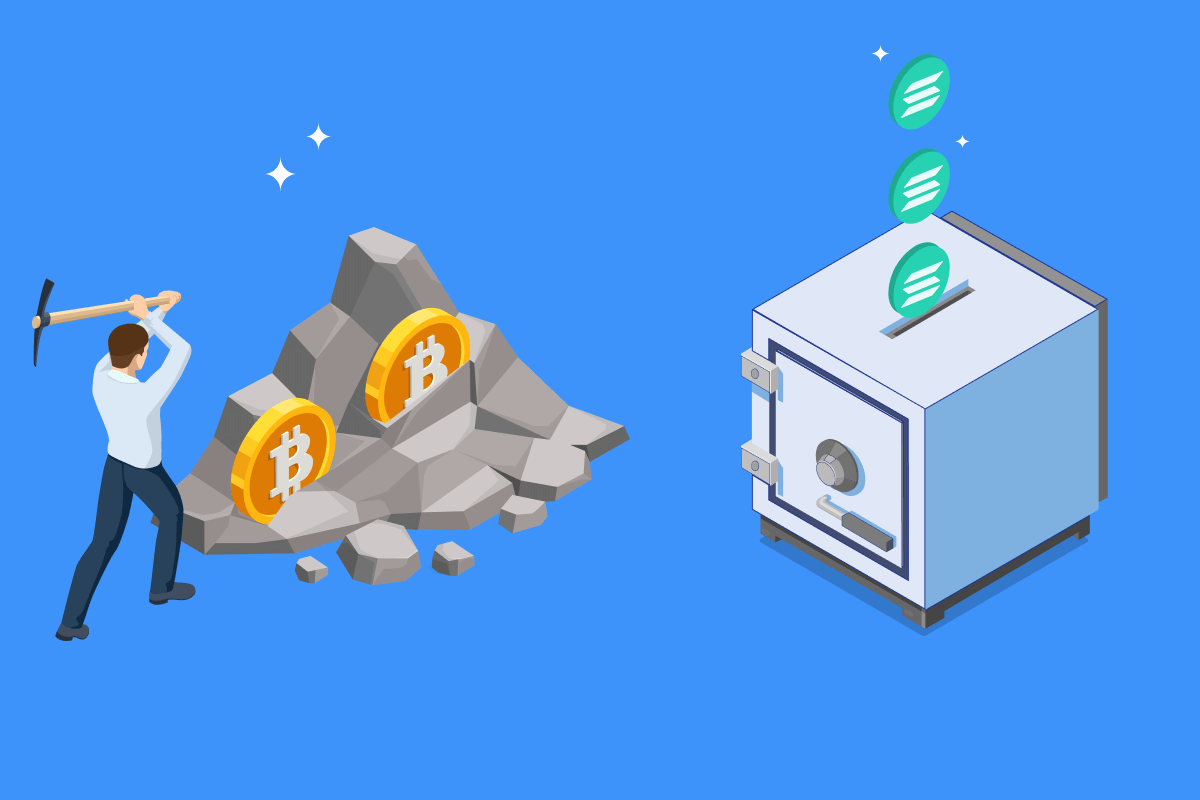Cryptocurrency is a high-risk asset class, and investing carries significant risk, including the potential loss of some or all of your investment. The information on this website is provided for informational and educational purposes only and does not constitute financial, investment, or trading advice. For more details, please read our editorial policy.
Proof of Stake vs. Proof of Work
08.01.2025 17:33 6 min. read Kosta GushterovWe may earn commissions from affiliate links or include sponsored content, clearly labeled as such. These partnerships do not influence our editorial independence or the accuracy of our reporting. By continuing to use the site you agree to our terms and conditions and privacy policy.

Blockchain technology has revolutionized the way we think about data security, financial transactions, and decentralized systems.
At the core of this technology are consensus mechanisms, which ensure that all participants in a blockchain network agree on the validity of transactions. Among these mechanisms, Proof of Stake (PoS) and Proof of Work (PoW) stand out as the most prominent and widely debated.
Proof of Work, the original consensus algorithm introduced by Bitcoin, relies on computational power to validate transactions and secure the network. Conversely, Proof of Stake offers an energy-efficient alternative, requiring participants to “stake” their cryptocurrency holdings as collateral to validate blocks. As the blockchain ecosystem grows, understanding the differences, advantages, and limitations of these mechanisms is crucial for developers, investors, and enthusiasts.
This article explores the fundamental differences between PoW and PoS, their impact on scalability, energy efficiency, and security, and their relevance in today’s evolving blockchain landscape. Platforms like Paragonix Earn provide valuable insights and tools for navigating the intricacies of blockchain and cryptocurrency trading.
What is Proof of Work?
Definition
Proof of Work (PoW) is a consensus mechanism where participants, called miners, solve complex mathematical puzzles to validate transactions and add new blocks to the blockchain. This process requires significant computational power and energy.
How It Works
- Mining Process:
- Miners compete to solve cryptographic puzzles.
- The first to solve the puzzle adds the block to the blockchain and receives a reward.
- Difficulty Adjustment:
- The network adjusts puzzle difficulty to maintain a consistent block production rate.
- Security:
- High computational requirements make it costly for malicious actors to attack the network.
Examples
- Bitcoin: The first and most well-known implementation of PoW.
- Ethereum (pre-Merge): Ethereum used PoW before transitioning to PoS in 2022.
What is Proof of Stake?
Definition
Proof of Stake (PoS) is a consensus mechanism where validators are chosen to create new blocks based on the amount of cryptocurrency they hold and are willing to “stake” as collateral.
How It Works
- Staking:
- Participants lock a portion of their cryptocurrency in a wallet.
- This stake acts as collateral, incentivizing honest behavior.
- Validator Selection:
- Validators are selected randomly, with higher stakes increasing the chances of selection.
- Rewards:
- Validators earn transaction fees and, in some cases, additional cryptocurrency rewards.
Examples
- Ethereum 2.0: Transitioned to PoS to improve scalability and energy efficiency.
- Cardano: Operates on the Ouroboros PoS protocol.
Comparing Proof of Work and Proof of Stake
Energy Efficiency
- Proof of Work:
- Consumes vast amounts of energy.
- Example: Bitcoin’s annual energy consumption rivals that of some countries.
- Proof of Stake:
- Requires minimal energy as no mining is involved.
- Example: Ethereum’s transition to PoS reduced its energy consumption by over 99%.
Scalability
- Proof of Work:
- Limited by the time and computational power required for mining.
- Example: Bitcoin processes approximately 7 transactions per second (TPS).
- Proof of Stake:
- Supports higher TPS due to faster block validation.
- Example: Cardano can handle hundreds of transactions per second.
Security
- Proof of Work:
- Security depends on the network’s total computational power.
- Vulnerable to 51% attacks if a single entity controls the majority of mining power.
- Proof of Stake:
- Security relies on economic incentives and the size of stakes.
- Attacks require a significant financial investment, deterring malicious behavior.
Decentralization
- Proof of Work:
- Tends to centralize due to mining hardware costs and energy requirements.
- Proof of Stake:
- Encourages broader participation as staking requires fewer resources.
Case Studies
Bitcoin and Proof of Work
- Scenario: Bitcoin’s PoW mechanism has secured the network since its inception in 2009.
- Outcome: Proven resilience against attacks, establishing Bitcoin as a digital gold standard.
- Lesson: PoW ensures robust security but at a high energy cost.
Ethereum’s Transition to Proof of Stake
- Scenario: Ethereum transitioned from PoW to PoS in 2022 to improve scalability and reduce energy consumption.
- Outcome: Energy use dropped by over 99%, and the network became more eco-friendly.
- Lesson: PoS offers a sustainable alternative for modern blockchain networks.
Pros and Cons of PoW and PoS
Proof of Work
Pros:
- High security and proven reliability.
- Decentralized mining incentivizes network participation.
Cons:
- Energy-intensive and environmentally unsustainable.
- Prone to mining centralization due to hardware costs.
Proof of Stake
Pros:
- Energy-efficient and eco-friendly.
- Supports higher transaction throughput and scalability.
Cons:
- Potential for wealth centralization as larger stakes dominate.
- Requires robust economic incentives to deter malicious actors.
Future of Proof of Stake and Proof of Work
- Hybrid Models:
- Combining PoW and PoS features to balance security and efficiency.
- Regulatory Focus:
- Increasing scrutiny on energy consumption may favor PoS adoption.
- Technological Advancements:
- Innovations may further optimize both mechanisms, enhancing their utility.
Conclusion
The debate between Proof of Stake and Proof of Work highlights the evolving nature of blockchain technology. While PoW has demonstrated unparalleled security and reliability, its energy demands have spurred the adoption of PoS as a greener, more scalable alternative. Platforms like Paragonix Earn enable users to engage with these mechanisms effectively, offering insights into their trading and investment implications.
As blockchain technology advances, both consensus mechanisms will likely coexist, catering to different use cases and network requirements. By understanding their strengths and limitations, stakeholders can make informed decisions that align with their goals and values.
FAQs
What is the main difference between PoW and PoS?
PoW relies on computational power to validate transactions, while PoS uses staked cryptocurrency as collateral for block validation.
Which is more energy-efficient, PoW or PoS?
PoS is significantly more energy-efficient, consuming over 99% less energy than PoW.
How does PoW ensure network security?
PoW secures the network by requiring miners to solve computational puzzles, making attacks costly and resource-intensive.
Can PoS networks be hacked?
While not immune to attacks, PoS networks require attackers to control a significant stake, making malicious actions economically unviable.
What are examples of PoW blockchains?
Bitcoin and Litecoin are prominent examples of PoW blockchains.
What are examples of PoS blockchains?
Ethereum 2.0, Cardano, and Polkadot are popular PoS blockchains.
Why did Ethereum switch to PoS?
Ethereum transitioned to PoS to improve scalability, reduce energy consumption, and enhance network efficiency.
Is PoW better for decentralization?
PoW can lead to centralization due to high mining costs, whereas PoS encourages broader participation.
What role does Paragonix Earn play in understanding PoW and PoS?
Paragonix Earn provides tools and insights to navigate blockchain mechanisms, enhancing trading strategies.
Will PoW and PoS coexist in the future?
Yes, both mechanisms are likely to coexist, serving different use cases and network needs.
This publication is sponsored. CryptoDnes does not endorse and is not responsible for the content, accuracy, quality, advertising, products or other materials on this page. Readers should do their own research before taking any action related to cryptocurrencies. CryptoDnes shall not be liable, directly or indirectly, for any damage or loss caused or alleged to be caused by or in connection with use of or reliance on any content, goods or services mentioned.
-
1
Best Crypto to Buy Now As $1B Sell-Off Crashes the Market – Buy The Dip Coins
24.06.2025 12:21 8 min. read -
2
Best Crypto Presales to Buy for Q3: 4 Promising ICOs
24.06.2025 17:55 5 min. read -
3
Best Altcoins to Buy Now: 5 Low-Cap Cryptos That Could Explode in Q3
25.06.2025 23:39 5 min. read -
4
Best Crypto Presales That Whales Are Adding to Their Portfolios for July
27.06.2025 17:05 6 min. read -
5
BTC Bull Token Presale Nears $8 Million with Just 24 Hours to Go: Next 100x Crypto?
29.06.2025 12:34 5 min. read
Best Crypto Presales to Invest in this Month: 4 Projects with Huge Potential
The overall crypto market cap is now valued at $3.47 trillion, marking a 2.36% jump over the past week and a near 50% increase year-on-year. This wave of bullish sentiment is partly driven by fresh macro developments, including the U.S. government’s pro-crypto stance and new housing policies that could soon allow crypto assets to count […]
BTC Bull Token Presale Enters Final 24 Hours Ahead of Exchange Listing Tomorrow: Next Crypto to Explode?
BTC Bull Token has reached a critical moment. With less than 24 hours left in its presale, the project has already raised $8 million, signalling huge investor confidence. Buyers now have one last chance to secure tokens at a lower price before claiming goes live and the token becomes tradable on exchanges. Many crypto traders […]
Best Crypto to Buy Now as $8.6B Bitcoin Whale Awakens After 14 Years
When a Bitcoin whale that had lain dormant since 2011 sprang to life this week, it unleashed a colossal 80,000 BTC, worth about $8.6 billion, onto the blockchain. Such a historic stir not only shattered records for daily movements of decade‑old coins but also underscored how long‑term holders can reshape market dynamics in a heartbeat. THE FINAL […]
Best Crypto Presales: BTC Bull Token Raises $8 Million, Just 48 Hours to Go Until Exchange Launch
One of the most talked-about new meme coin launches of 2025, BTC Bull Token (BTCBULL) has already raised over $8 million through its presale, signalling huge investor confidence. BTC Bull Token stands out by tracking Bitcoin’s performance and rewarding BTCBULL holders whenever BTC hits specific milestones for the first time. The concept blends meme coin culture […]
-
1
Best Crypto to Buy Now As $1B Sell-Off Crashes the Market – Buy The Dip Coins
24.06.2025 12:21 8 min. read -
2
Best Crypto Presales to Buy for Q3: 4 Promising ICOs
24.06.2025 17:55 5 min. read -
3
Best Altcoins to Buy Now: 5 Low-Cap Cryptos That Could Explode in Q3
25.06.2025 23:39 5 min. read -
4
Best Crypto Presales That Whales Are Adding to Their Portfolios for July
27.06.2025 17:05 6 min. read -
5
BTC Bull Token Presale Nears $8 Million with Just 24 Hours to Go: Next 100x Crypto?
29.06.2025 12:34 5 min. read

